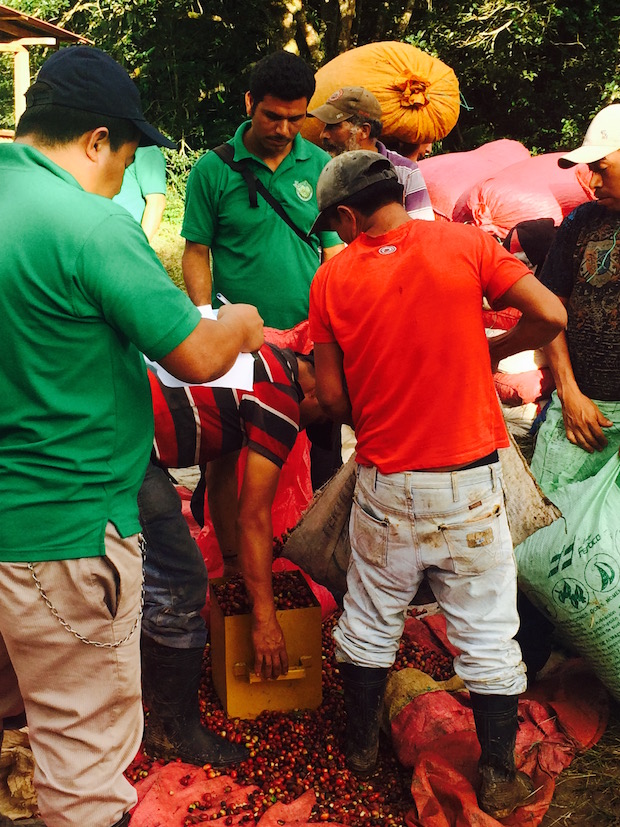(editor’s note: This is the fourth post in an ongoing series in which members of the SCAA Sustainability Council will be addressing their current work, while sharing opportunities and insight for coffee industry involvement.)
Maps provide us knowledge of where we are, and help us navigate our way to our destination. They tell us how far we’ve come, and how far we have yet to go. Without maps, we’re blind to what challenges or obstacles lie ahead.
Coffee buyers know that the geography of their work is global, and while each buyer relates at different levels of intimacy to the multiple links in their supply chain, it’s fair to say that somewhere past the importer, past port, past the mill, or perhaps, past the farm gate, the map goes blank.
Maps and Farmworkers
Inevitably, at the end of the map — or the beginning, depending on how you look at it — is a farmworker picking coffee cherries, carrying them down the slope in heavy bags, and delivering them for weighing and paying. Who is this worker? Are they being paid fairly? Are their living conditions dignified? Are they children? Are they subject to abuse from an exploitative labor broker, or to sexual harassment and violence?
These farmworkers are the backbone of specialty coffee, yet companies know next to nothing about who they are, what their working conditions are like, or how to be better partners in the production of great coffee.
The question of farmworker inclusion is critical to the viability of the specialty coffee industry. We all know that the production of great coffee requires careful attention to detail, starting with harvesting. It requires skilled laborers.
Unfortunately, it’s becoming increasingly clear that the labor force required to produce great coffee is disappearing. Labor shortages in Colombia have become acute annual events. The situation throughout much of Central America is not much better.
For those that do stay in coffee, the exploitation of farmworkers is all too common — often times driven intentionally or unintentionally by the fundamental economics of coffee production. Failure to include farmworkers in a meaningful way as part of the specialty coffee industry presents an existential threat to its survival and myriad risks to the reputations of individual companies, and the specialty coffee brand itself.
Mapping Risk
Mapping your supply chain is a critical starting place for identifying and addressing labor risk. This means putting a magnifying glass on each interconnected link, from importer, to exporter, to mill, cooperative or farm, and ultimately farmworker. Mapping is an exercise in transparency, into the relationships that cascade back to origin. It’s the articulation of the path each and every bag of coffee took to arrive at your warehouse door.
A map of your supply chain establishes an understanding of where your coffee comes from, who produces it, where there is risk of labor abuse or exploitation. This kind of mapping is not easy. In fact, in many ways, it’s a new idea, and presents profound challenges to the industry’s status quo.
Buyers should be aware that their suppliers are unlikely to be comfortable opening up their books and operations to share information that they view as proprietary. Before you ask for transparency, you have to build trust. Buyers should also know that a lack of good data in many links makes mapping a very manual, in-person and ultimately expensive process.
Increasing demand for information and reporting from the roastery to origin without offering value in the form of increased preference, price or other direct value is not a sustainable strategy.
Mapping the Future
However, when it is accomplishable, mapping enables companies to identify risk and engage their supply chain partners to mitigate them. The goal is to create a mechanism to navigate your way to a better future. Companies don’t have to do it alone — there are great partners waiting in the wings, including their suppliers, certifiers, NGOs and governments — but they need to take responsibility for shifting the dynamic of coffee supply chains from opaque to transparent, and for shifting toward open engagement in incentives.
The better the map, the more useful it is as a tool to navigate complex and difficult terrain. It’s on us, the specialty coffee industry, to come together to improve our visibility into the reality of farmworkers so that we can create a safe space to explore and achieve change that will benefit the people who make every cup of coffee possible.
The existence of that cup itself depends on it.
Ben Corey-Moran
As Director of Coffee Supply at Fair Trade USA, Ben Corey-Moran manages supply chain development efforts to serve the needs of farmers, the trade, and a growing community of roasters and brands. Ben is a member of the Specialty Coffee Association of America’s Sustainability Council, where he supports the Farmworker Inclusion workstream.







Comment